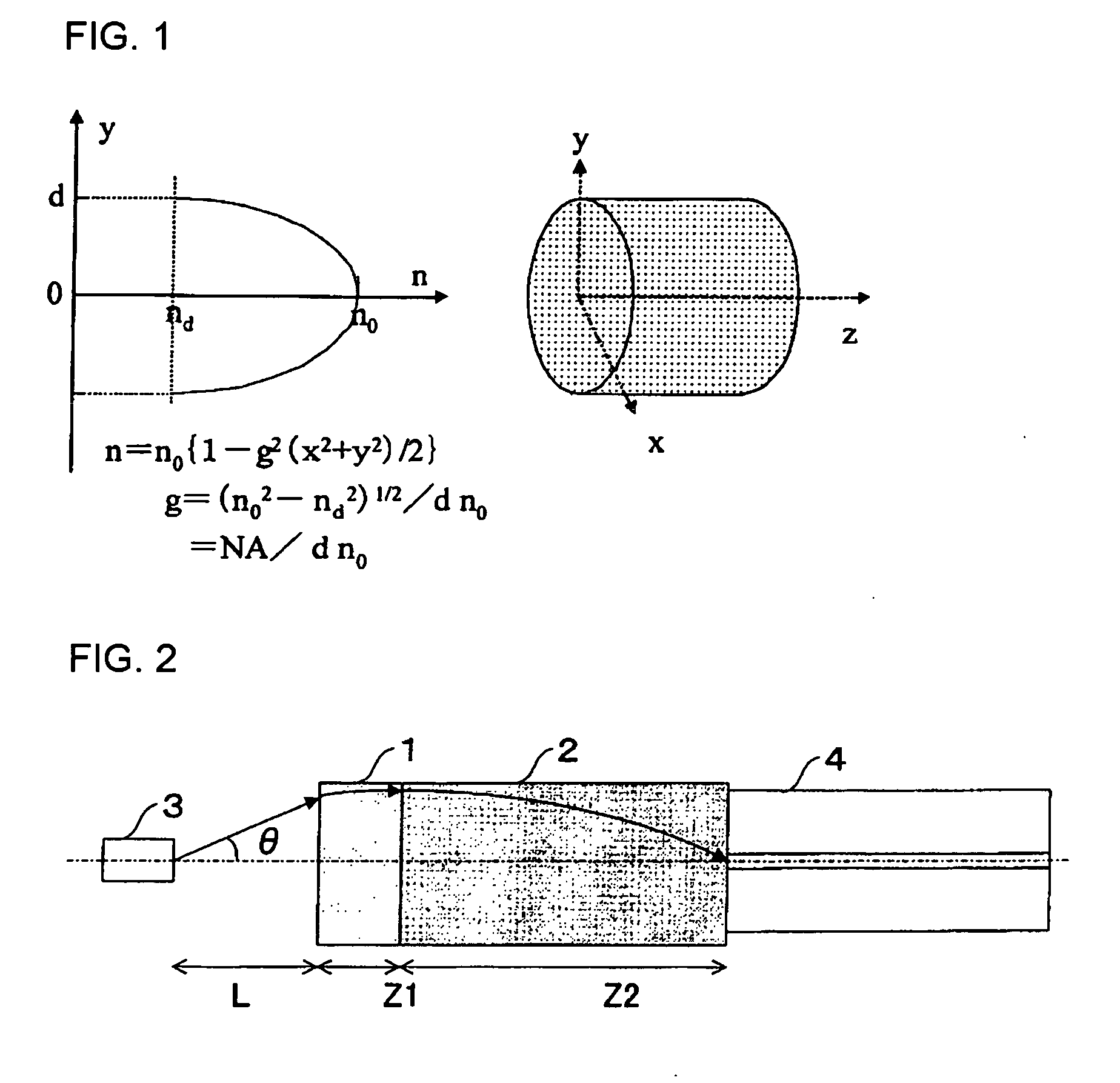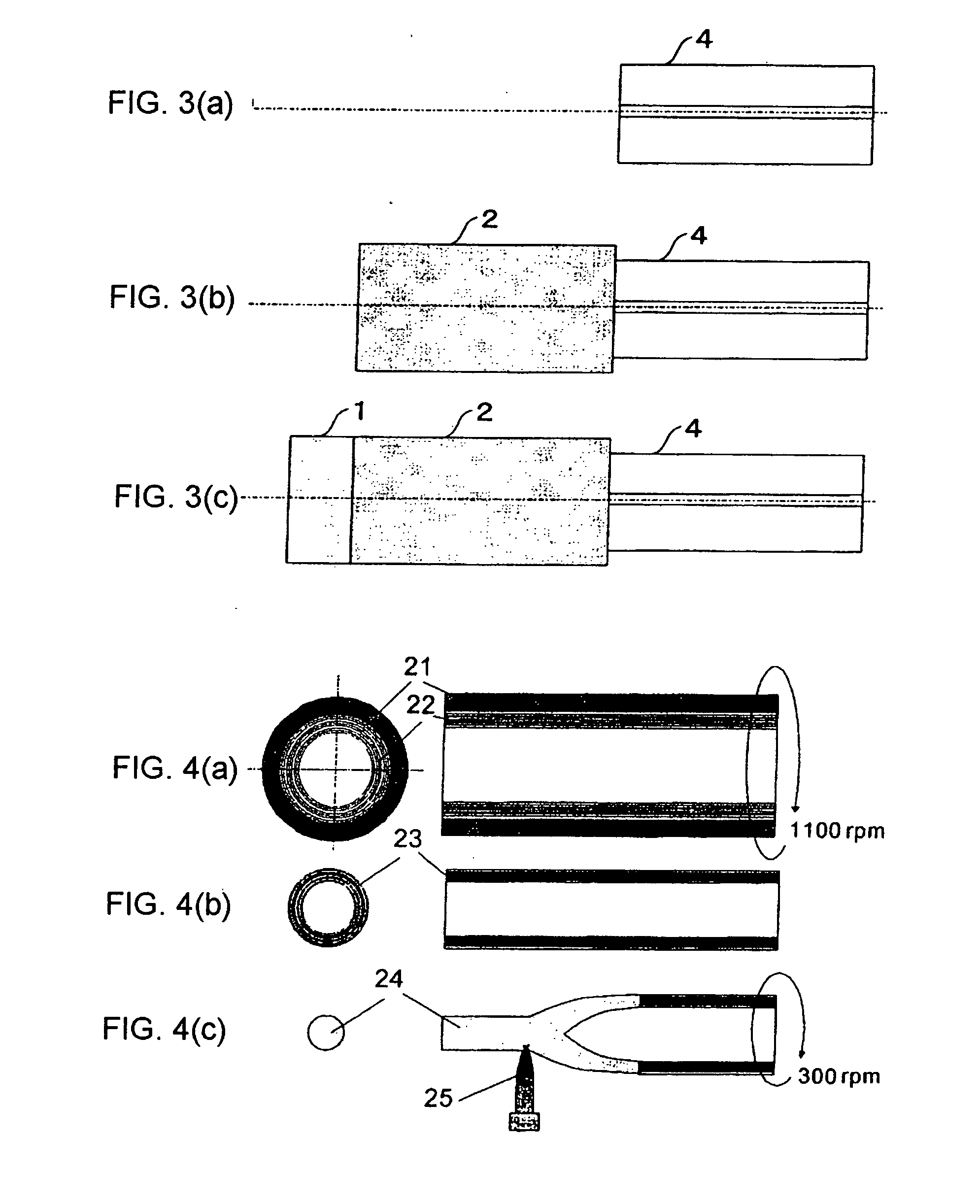Optical fiber coupling componet
a technology of optical fiber and coupling part, applied in the field of optical fiber coupling part, can solve the problems of increasing manufacturing cost, deteriorating mass-productivity, and inability to use coupling method for semiconductor laser array and optical fiber array
- Summary
- Abstract
- Description
- Claims
- Application Information
AI Technical Summary
Benefits of technology
Problems solved by technology
Method used
Image
Examples
embodiment 1
[0047] 2 normal hydrochloric acid 9.2 ml was added into a mixture of 75.5 ml silicon tetramethoxide and 183.4 ml isopropanol, and after stirring for 30 minutes, 9.8 ml titanium tetra-n-butoxide was added. Thereafter, 0.01 normal ammonia water was added, and stirred, to obtain a wet gel. After aging the wet gel at a temperature of 50° C. for two days, the wet gel is immersed in 6 normal hydrochloric acid for two hours, so that titanium on an outer periphery is eluted, and concentration distribution of titanium was imparted in the gel. After being immersed, the wet gel is dried at a temperature of 70° C., to obtain a dry gel having about 10 mm diameter. The dry gel thus obtained was subjected to temperature-raise from room temperature to 800° C. at a rate of 150° C. / hr in an oxygen atmosphere, and thereafter to 1250° C. at a rate of 50° C. / hr in a helium atmosphere, and then subjected to baking to obtain a transparent glass body. The refractive index distribution of the columnar glass...
embodiment 2
[0051] First, in the same process as the first embodiment, after forming the preform of the second GRIN lens having numerical aperture satisfying NA=0.16, the preform was formed into the second GRIN lens-like optical fiber having 150 μm outer diameter by spinning in the electric furnace of the carbon heater.
[0052] Next, after 2 normal hydrochloric acid 9.2 ml was added into a mixture of 76.6 ml silicon tetramethoxide and 184.3 ml isopropanol, 50 ml superfine particulate silica was added to mix therewith, and the mixture thus obtained was stirred for 1 hour and partially hydrolyzed. Then, the solution was divided equally into eight parts, and added with titanium tetra-n-butoxide of concentration as shown in Table 1, to make eight kinds of sol from first layer to eighth layer with different titanium components at regular intervals. Thereafter, 0.01 normal ammonia water was added at regular intervals to adjust the sol.
[0053] First, the sol of the first layer was contained in a polypr...
embodiment 3
[0057] First, in the same process as the first embodiment, after forming the preform of the second GRIN lens having numerical aperture satisfying NA=0.16 was formed, the preform was formed into the second GRIN lens-like optical fiber having 150 μm outer diameter by spinning in the electric furnace of the carbon heater.
[0058] Subsequently, tantalum ethoxide was added to and mixed with 1.1 g silicon tetramethoxide by an amount of eight kinds shown in table 2, and 1.3 cc methanol was further added and mixed therein, and the mixture thus obtained was stirred. Thereafter, 0.3 g superfine particulate silica was mixed therein, and after stirring for one hour, 1.3 cc methanol and 0.3 cc pure water were mixed and delivered by drops therein to adjust the sol.
[0059] First, the sol of the first layer was contained in the cylindrical polypropylene vessel having 50 mm inner diameter, and the sol thus contained was rotated at a speed of 1000 revolutions per one minute for 30 minutes to form a cy...
PUM
 Login to View More
Login to View More Abstract
Description
Claims
Application Information
 Login to View More
Login to View More - R&D
- Intellectual Property
- Life Sciences
- Materials
- Tech Scout
- Unparalleled Data Quality
- Higher Quality Content
- 60% Fewer Hallucinations
Browse by: Latest US Patents, China's latest patents, Technical Efficacy Thesaurus, Application Domain, Technology Topic, Popular Technical Reports.
© 2025 PatSnap. All rights reserved.Legal|Privacy policy|Modern Slavery Act Transparency Statement|Sitemap|About US| Contact US: help@patsnap.com



